TWO NUCLEAR IMPERIALIST POWERS
CHINA AND INDIA
USE IRON RODS WITH SPIKES TO BATTLE IN THE HIMALAYAS OVER A BORDER DISPUTE
BARBARISM NOT SOCIALISM

China claims valley where Indian, Chinese soldiers brawled
EMILY SCHMALL Associated Press•June 19, 2020
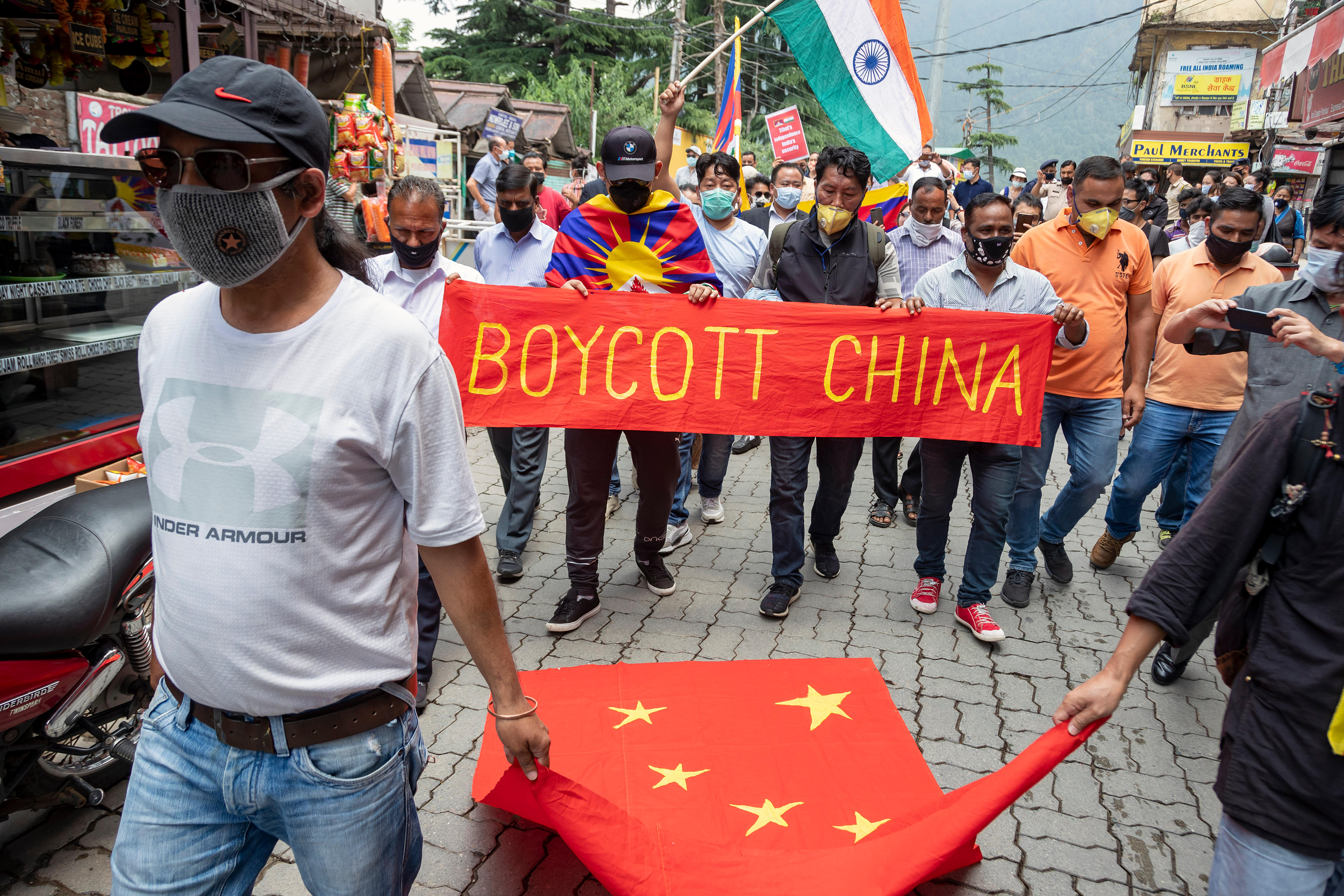
India Tibet China Protest
Exile Tibetans and local Indians participate in a protest against the Chinese government in Dharmsala, India, Friday, June 19, 2020. India said Thursday it was using diplomatic channels with China to de-escalate a military standoff in a remote Himalayan border region where 20 Indian soldiers were killed this week. (AP Photo/Ashwini Bhatia)
NEW DELHI (AP) — China said the Galwan Valley high up in the Himalayan border region where Chinese and Indian troops engaged in a deadly brawl this week falls entirely within China, boldly renewing claims on the disputed area as the Asian giants continued using military and diplomatic channels to try to reduce tensions on Saturday.
The confrontation in the Galwan Valley, part of the disputed Ladakh region along the Himalayan frontier, was the deadliest between the two countries in 45 years. India blames China for instigating the fight by developing infrastructure in the valley, which it said was a breach of the agreement of what area remained in dispute.
Chinese Foreign Ministry spokesperson Zhao Lijian said in a statement Friday that “the Galwan Valley is located on the Chinese side of the Line of Actual Control in the west section of the China-India boundary.”
He blamed incursions by Indian troops in the area from early May for a midnight clash on Monday that left 20 Indian soldiers dead. China has not said whether it suffered any casualties.
Soldiers brawled with clubs, rocks and their fists in the thin air at 4,270 meters (14,000 feet) above sea level, but no shots were fired, Indian officials have said. The soldiers carry firearms but are not allowed to use them under a previous agreement in the border dispute.
Indian security officials have said the fatalities were caused by severe injuries and exposure to subfreezing temperatures.
The valley falls within a remote stretch of the 3,380-kilometer (2,100-mile) Line of Actual Control — the border established following a war between India and China in 1962 that resulted in an uneasy truce.
Indian Ministry of External Affairs spokesperson Anurag Srivastava repeated on Saturday that China's claims to the valley were “exaggerated and untenable.”
“They are not in accordance with China’s own position in the past. Indian troops are fully familiar with the alignment of the (Line of Actual Control) in all sectors of the India-China border areas, including in the Galwan Valley. They abide by it scrupulously here, as they do elsewhere,” Srivastava said in a statement.
Prime Minister Narendra Modi said in a meeting with political opposition leaders on Friday that no one "has intruded into our territory, nor taken over any post.”
Modi said India was “hurt and angry” about the deaths of its troops. He said India wanted peace and friendship, but had the "capability that no one can even dare look toward an inch of our land.”
Also on Friday, Zhao, the Chinese Foreign Ministry spokesperson, said that China was not holding any Indian soldiers, without addressing media reports that China had released 10 of them late Thursday.
“My information is that at present there are no Indian personnel detained on the Chinese side,” Zhao said, according to an English version of his daily briefing posted on the ministry's website.
Indian officials have denied that any soldiers were in Chinese custody.
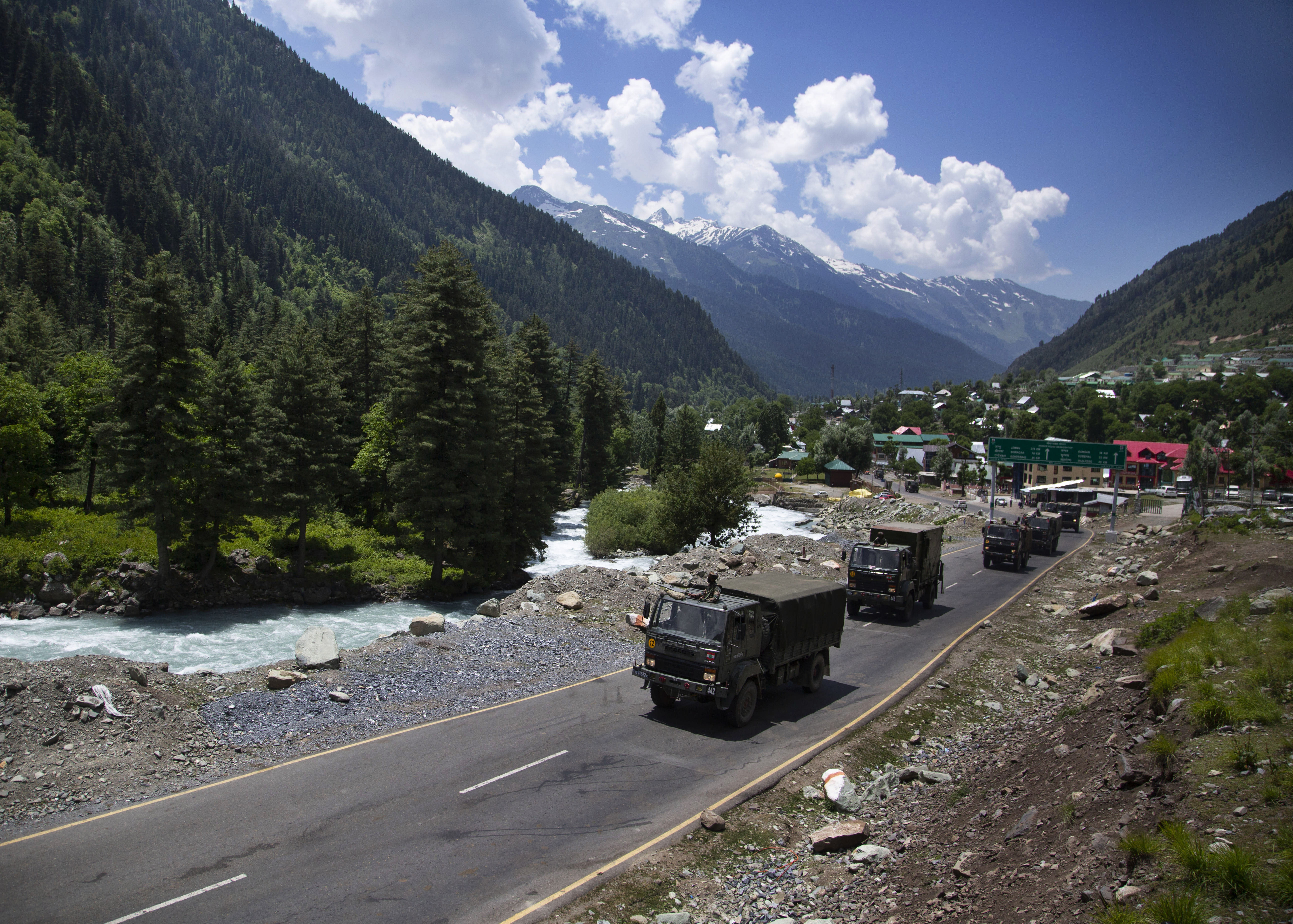
An Indian army convoy moves on the Srinagar- Ladakh highway at Gagangeer, northeast of Srinagar, India, Wednesday, June 17, 2020. Indian security forces said neither side fired any shots in the clash in the Ladakh region Monday that was the first deadly confrontation on the disputed border between India and China since 1975. China said Wednesday that it is seeking a peaceful resolution to its Himalayan border dispute with India following the death of 20 Indian soldiers in the most violent confrontation in decades. (AP Photo/Mukhtar Khan)
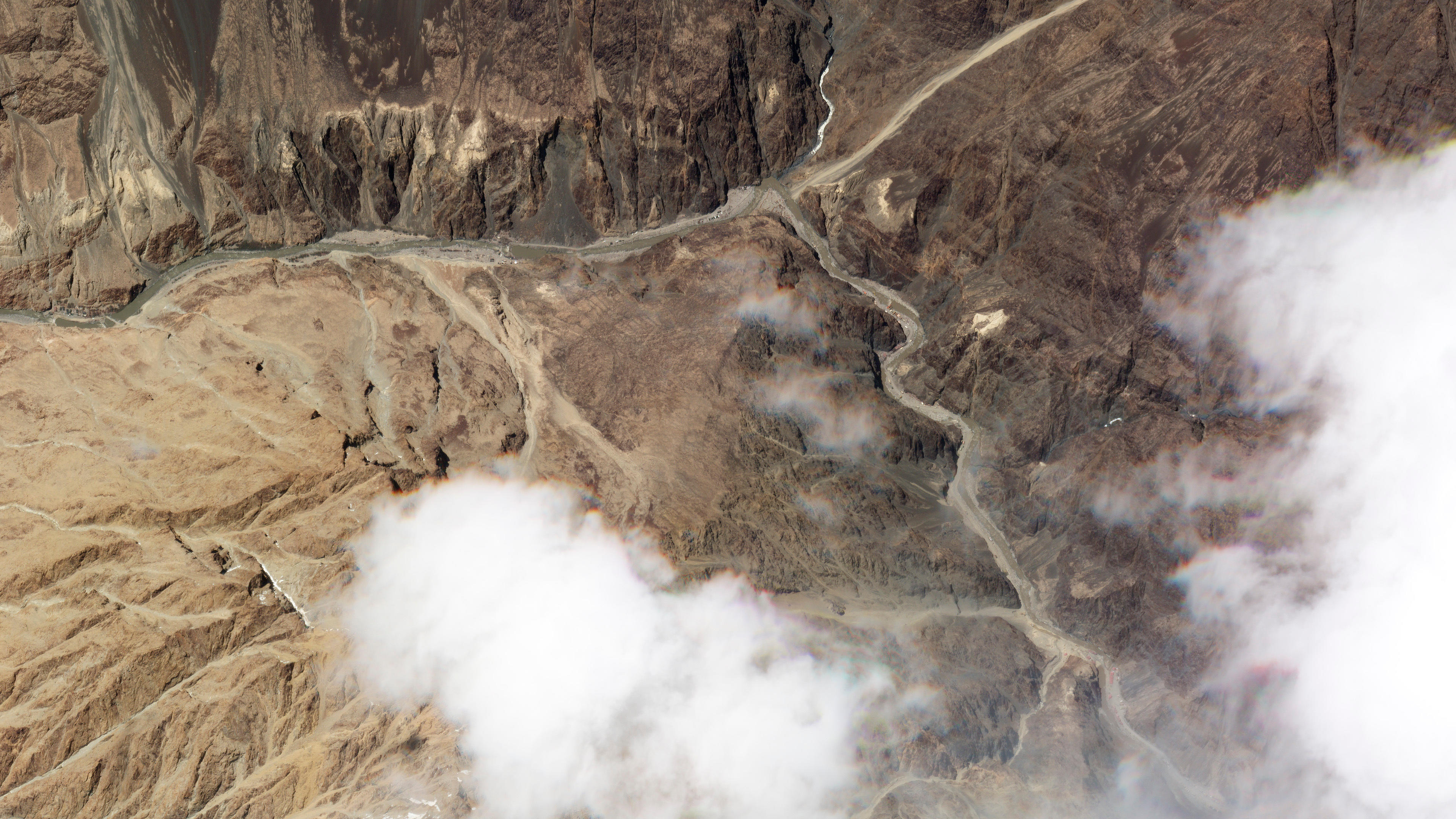
China India
This June 18, 2020, satellite photo released by Planet Labs, shows the reported site of a fatal clash between Indian and Chinese troops in the Galwan River Valley in the Ladakh region near the Line of Actual Control, BKalong their disputed border high in the Himalayas. (Planet Labs via AP)
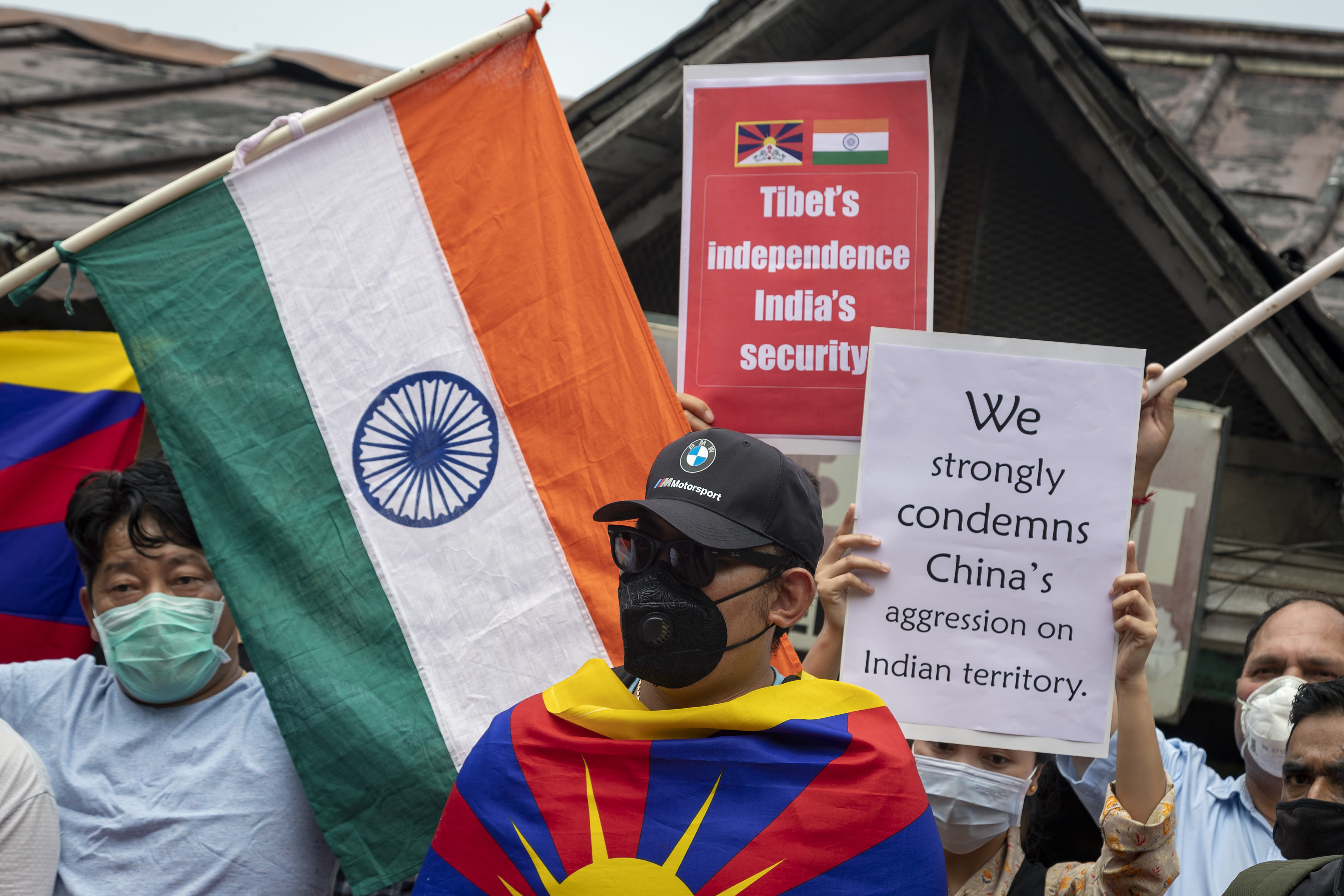
India Tibet China Protest
Exile Tibetans and local Indians participate in a protest against the Chinese government, in Dharmsala, India, Friday, June 19, 2020. India said Thursday it was using diplomatic channels with China to de-escalate a military standoff in a remote Himalayan border region where 20 Indian soldiers were killed this week. (AP Photo/Ashwini Bhatia)
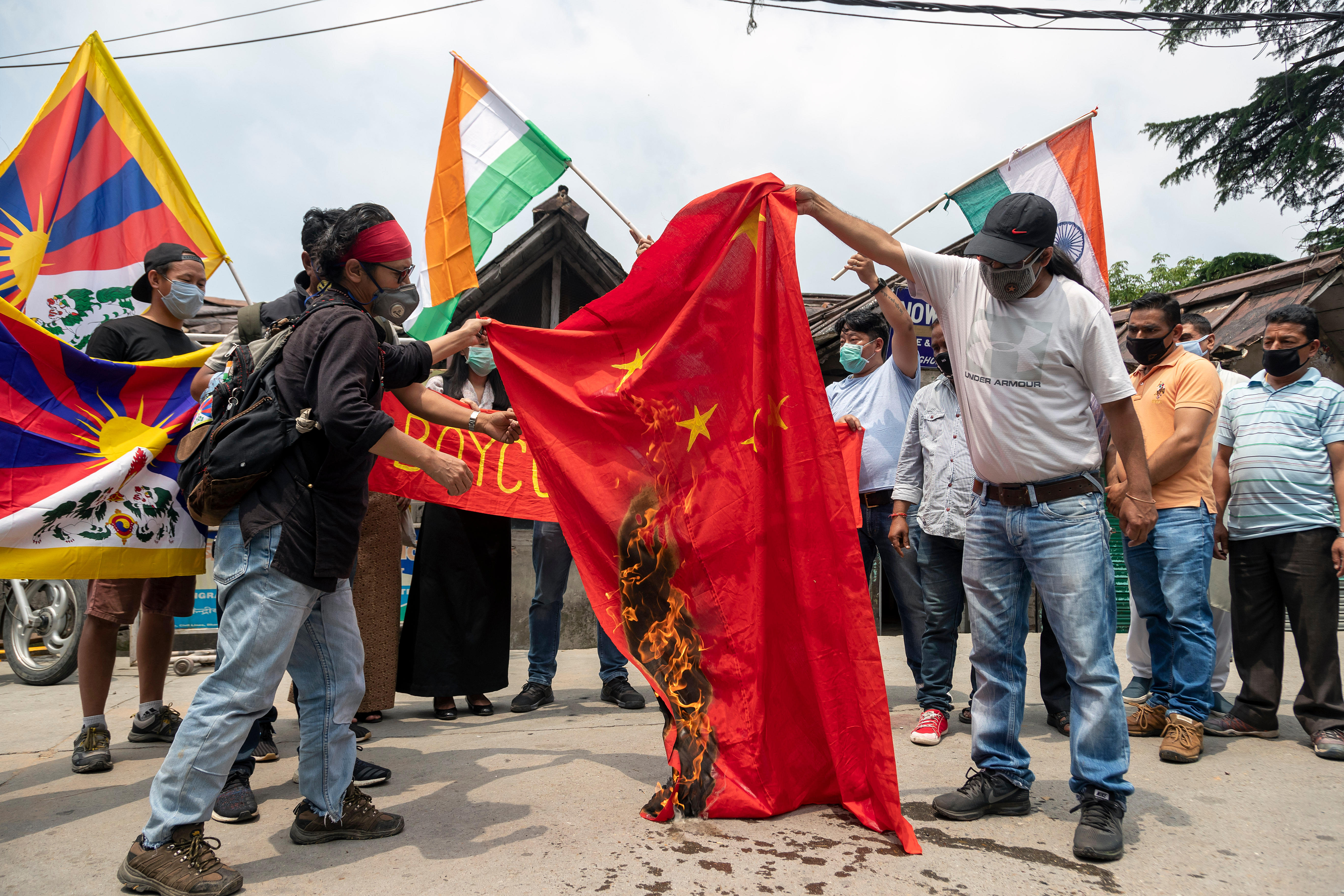
India Tibet China Protest
Exile Tibetans and local Indians burn a Chinese national flag during a protest in Dharmsala, India, Friday, June 19, 2020. India said Thursday it was using diplomatic channels with China to de-escalate a military standoff in a remote Himalayan border region where 20 Indian soldiers were killed this week. (AP Photo/Ashwini Bhatia)
India, China accuse each other of violating de facto border
Reuters•June 20, 2020
Border Clash Between India and China Turns Deadly
NEW DELHI/BEIJING (Reuters) - India and China on Saturday each traded accusations that the other had violated their shared de facto border, an area that this week became the site of the deadliest clash in half a century between the two nuclear-armed giants.
A day after Indian Prime Minister Narendra Modi sought to downplay Monday's clash, which killed at least 20 Indian soldiers and injured more than 70, his government blamed the Chinese side for seeking to erect structures "just across the Line of Actual Control," as the demarcation is known, and refusing India's request to stop.
India will not allow any unilateral changes to the disputed border, it said in a statement.
Chinese foreign ministry spokesman Zhao Lijian accused Indian troops of a "deliberate provocation" in the tense Himalayan area.
In a series of tweets, Zhao said the Galwan Valley was on the Chinese side of the line and that Indians had since April unilaterally built roads, bridges and other facilities in the region.
The Indian troops "crossed the Line of Actual Control" and attacked Chinese officers and soldiers who were there for negotiation, triggering "fierce physical conflicts", Zhao said. China has not released any casualty figures for its troops.
Modi on Friday appeared to downplay the clash with Chinese troops, saying, "Nobody has intruded into our border, neither is anybody there now, nor have our posts been captured."
Troops remain locked in a face-off at several locations along the poorly defined Line of Action Control, despite talks between local commanders to de-escalate.
(Reporting by Aftab Ahmed in New Delhi and Tom Daly in Beijing; Editing by William Mallard)
POST MODERN PRIMITIVES
Galwan Valley: Image appears to show nail-studded rods used in India-China brawl
BBC•June 18, 2020

An image has emerged showing a crude weapon purportedly used by Chinese forces in the fatal brawl along China's disputed border with India on Monday.
The fight in the Galwan Valley left at least 20 Indian soldiers dead and raised tensions between the two powers.
China did not acknowledge any casualties among its forces. Both sides accused the other of an incursion.
The border between the two nations in the region is poorly demarcated and can shift with topographical changes.
The image that emerged on Thursday showed crude weapons that appeared to be made from iron rods studded with nails. It was passed to the BBC by a senior Indian military official on the India-China border, who said the weapons had been used by the Chinese.

An image passed to the BBC by an Indian military official shows crude weapons purportedly used in the fight
Defence analyst Ajai Shukla, who first tweeted the image, described the use of such weapons as "barbarism". The absence of firearms in the clash dates back to a 1996 agreement between the two sides that guns and explosives be prohibited along the disputed stretch of the border, to deter escalation.
The image was widely shared on Twitter in India, prompting outrage from many social media users. Neither Chinese or Indian officials commented on it.
Media reports said troops clashed on ridges at a height of nearly 4,267m (14,000 ft) along a steep terrain, with some soldiers falling into the fast-flowing Galwan river in sub-zero temperatures.
First deaths in four decades
The two sides have brawled along the disputed border in recent weeks, but Monday's clash was the first to lead to fatalities in at least 45 years. Unconfirmed reports in Indian media said at least 40 Chinese soldiers died, but China is yet to issue any information about casualties.Indian officials said all of their soldiers involved in the clash have been accounted for, following reports some were missing.
Chinese foreign ministry spokesman Zhao Lijian said India had crossed the border twice, "provoking and attacking Chinese personnel, resulting in serious physical confrontation between border forces on the two sides", the AFP news agency reported.
China on Wednesday claimed "sovereignty over the Galwan Valley region" - a claim rebutted by India as "exaggerated and untenable".

Indian army trucks move along a highway leading to Ladakh on Wednesday
Members of the public in both nations have since staged protests over the clashes in the disputed Himalayan border area, while officials have spoken cautiously and moved towards a diplomatic resolution.
Indian foreign ministry spokesperson Anurag Srivastava said the foreign ministers of both countries had shared a phone conversation on Wednesday on the developments and "agreed that the overall situation should be handled in a responsible manner".
"Making exaggerated and untenable claims is contrary to this understanding," Mr Srivastava was quoted as saying by Press Trust of India news agency.
An Indian government statement after Subrahmanyam Jaishankar's conversation with China's Wang Yi said Chinese forces tried to erect a structure on the Indian side of the de facto border, the Line of Actual Control (LAC).
The statement accused the Chinese of a "premeditated and planned action that was directly responsible for the resulting violence and casualties" and urged China to "take corrective steps".
Meanwhile, a Chinese statement quoted Mr Wang as saying: "China again expresses strong protest to India and demands the Indian side launches a thorough investigation... and stop all provocative actions to ensure the same things do not happen again."

Kashmir map
Why were there no guns?
The Galwan river valley in Ladakh, with its harsh climate and high-altitude terrain, lies along the western sector of the LAC and close to Aksai Chin, a disputed area claimed by India but controlled by China.
This is not the first time the two nuclear-armed neighbours have fought without conventional firearms on the border. India and China have a history of face-offs and overlapping territorial claims along the more than 3,440km (2,100 mile), poorly drawn LAC separating the two sides.
The last firing on the border happened in 1975 when four Indian soldiers were killed in a remote pass in the north-eastern state of Arunachal Pradesh. The clash was variously described by former diplomats as an ambush and an accident. But no bullets have been fired since.
At the root of this is a 1996 bilateral agreement that says "neither side shall open fire... conduct blast operations or hunt with guns or explosives within two kilometres of the Line of Actual Control".
But there have been other tense confrontations along the border in recent weeks. In May Indian and Chinese soldiers exchanged physical blows on the border at Pangong Lake, also in Ladakh, and in the north-eastern Indian state of Sikkim hundreds of miles to the east.
India has accused China of sending thousands of troops into Ladakh's Galwan Valley and says China occupies 38,000 sq km (14,700 sq miles) of its territory. Several rounds of talks in the last three decades have failed to resolve the boundary disputes.
Nuclear powers, a disputed border and an uneasy truce: Explaining the India-China conflict
Saphora Smith and Adela Suliman and Vivi Wu and Ed Flanagan and The Associated Press
NBC News•June 20, 2020
High up in the Himalayas, Indian and Chinese armed forces warily eye each other across a disputed border region that has become the scene of a tense standoff between the two nuclear powers.
The conflict in the remote Galwan Valley that spans their shared border sparked into life Monday with the killing of 20 Indian soldiers, the first reported deaths in 45 years. China has not disclosed whether its forces suffered any casualties, according to a report in its state-run newspaper, the Global Times.
The deaths have drawn the world’s gaze to a region that the two most populous countries have been contesting for decades. The implications go far beyond the lonely snowcapped mountains of this geopolitically complex region.

Burning posters of Chinese President Xi Jinping (Diptendu Dutta / AFP - Getty Images)
Chinese and Indian forces clashed along the 2,100-mile-long Line of Actual Control, a demarcation line established after a war between the two nations in 1962 that resulted in an uneasy truce.
No shots are reported to have been fired since 1975, according to the Indian press, but troops occasionally engage in hand-to-hand scuffles and throwing rocks.
So what happened this week?
The details of exactly what happened Monday remain in short supply.
Chinese Foreign Minister Wang Yi said in a phone call with his Indian counterpart, Subrahmanyam Jaishankar, on Wednesday that Indian troops had crossed the line of control to “deliberately provoke and even violently attack” Chinese officers and soldiers, the Chinese foreign ministry said.
Meanwhile, on the same call Jaishankar accused China of seeking to erect “a structure” in the Galwan Valley on the Indian side of the Line of Actual Control, the de facto border.
“The Chinese side took premeditated and planned action that was directly responsible for the resulting violence and casualties,” India’s Ministry of External Affairs said in a statement. “It reflected an intent to change the facts on ground in violation of all our agreements to not change the status quo.”
Why is this happening now?
Thousands of troops have been camped either side of the Galwan Valley, in the mountainous region of Ladakh, for weeks.
The tense standoff started in early May, when Indian officials said Chinese soldiers crossed the boundary in Ladakh at three different points, erecting tents and guard posts and ignoring verbal warnings to leave, according to The Associated Press. That triggered shouting matches, stone-throwing and even fistfights between the two sides, much of it replayed on television news channels and social media, the news agency reported.
What are the possible motivations behind the clashes?
Under India’s Hindu-nationalist prime minister, Narendra Modi, the country wants to be seen as strong, according to Gareth Price, a senior research fellow at Chatham House, an international affairs think tank in London.
“The one country that doesn’t respect India to the degree India would like is China,” he said. “India wants to be seen as an equal to China and talks about a multipolar Asia, but then it sees China as wanting dominance in Asia.”
However, Price said he thought it was unlikely that India would want to provoke China potentially to war particularly in the midst of a pandemic.
“It also knows China is bigger,” he said.
China on the other hand may have possible reasons to provoke a confrontation with India, Price said, although he cautioned that an overriding motivation there also remained unclear.
Among the reasons raised by analysts include China’s objection to India’s construction of a road through the Galwan Valley connecting the region to an airstrip, New Delhi’s increasing close alliance with Washington, and Beijing’s support for Pakistan in its dispute with India over the Kashmir region.

Image: An Indian army convoy (Mukhtar Khan / AP)
Others also pointed to China’s increasing assertiveness in the region as a potential broader explanation.
Walter Ladwig III, a senior lecturer in international relations at King’s College London, pointed to its more forceful conduct in the South China Sea and Hong Kong in recent months.
“There definitely is a clear sense that China is much more forceful at the moment than it has been in the past,” he said.
“They’re throwing their weight around a lot more in all theaters, both domestically and in terms of their foreign relations,” said Nick Reynolds, a research analyst at the Royal United Services Institute for Defence and Security Studies in London.
How dangerous is the clash?
India has said both sides had agreed not to “escalate matters and instead, ensure peace and tranquility.”
Modi echoed this but also underlined that India would give a “befitting reply” to any provocation. “India will firmly protect every inch of the country's land and its self-respect,” he said.
The Chinese foreign ministry also said both sides agreed after Monday’s clash to “cool the current situation” as soon as possible and “safeguard peace and tranquility in the border areas.”
The stakes are high. In the past year, China has increased its nuclear arsenal from 290 to 320 warheads, and India from 130-140 to 150 warheads, according to the Stockholm International Peace Research Institute, or SIPRI.Experts say the broader dispute itself is not going away any time soon and Price points out that an agreement between New Delhi and Beijing after clashes in 2017 did nothing to stop this week’s deaths.
“No troops have died on this border since 1975, so this is kind of new territory,” he said.
Both Price and Reynolds said it would be difficult for either government to be seen to back down, considering their domestic politics. But Reynolds said international pressure may help and Price said there may be a way for both countries to claim victory but at the same time mutually back away.
“The elevation and terrain of this area means it’s highly unlikely this could escalate large scale,” Ladwig said. “But there’s plenty of opportunity for small-scale mistakes, skirmishes, accidents.”
Fighting the elements, not the enemy, on India's China border
Aishwarya KUMAR AFP•June 20, 2020
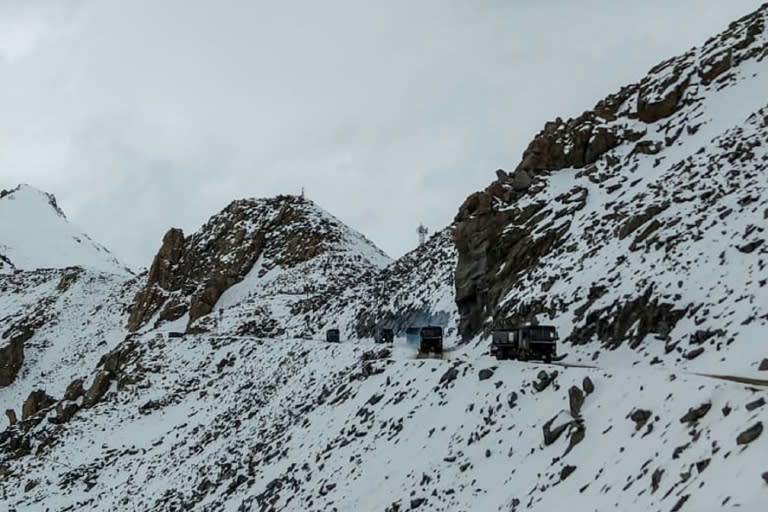
The terrain is so high that soldiers need time to acclimatise to their new posting or they run the risk of serious altitude sickness that can kill even a healthy young person in hours (AFP Photo/STR)
Death is a real and constant danger for the soldiers serving on India's Himalayan border with China, but until a deadly brawl on June 15 the only killers since 1975 have been the topography and the elements.
"We get more than 100 casualties every year just due to terrain, weather conditions, avalanches... There is constant danger," said retired Lt. General DS Hooda, who until 2016 headed India's Northern Command.
"You're talking about 14-15,000 feet (4,300-4,600 metres). It takes a huge toll on your physical and mental condition," Hooda told AFP after Monday's brutal hand-to-hand battle with fists, rocks and clubs which saw the first Indian combat deaths with China in over four decades.
In the "cold desert" of the Galwan river valley in the Ladakh region where the fighting took place, winter temperatures can plunge below minus 30 Celsius (minus 22 Fahrenheit), cracking gun barrels and seizing up machinery.
There are few roads so troops -- who are fed a special high-protein diet -- must slog through the thin air themselves, carrying their own equipment as they navigate treacherous terrain.
For those who get injured or fall sick "evacuation becomes an enormous challenge," Hooda said. Getting them to a helipad "can take hours", and as soon as night falls, it's too dangerous for helicopters to fly.
This may be why the initial death toll of three shot up to 20 late on Tuesday.
Seventeen other troops critically injured in the clashes, which lasted until after midnight, were "exposed to sub-zero temperatures in the high altitude terrain" and succumbed to their injuries, the army said.
- Cold and confused -
The terrain is so high that soldiers need time to acclimatise to their new posting or they run the risk of serious altitude sickness that can kill even a healthy young person in hours.
"For an average human being who is not a resident of that place, survival in itself is a huge challenge," said Colonel S Dinny, who until 2017 commanded an Indian battalion in the region, told AFP.
"It is one of the toughest places to serve as a soldier," he said.
Normally soldiers do a two-year posting there, broken up by periods of leave. Those who smoke quickly kick the habit.
"With such low oxygen plus the weather plus the smoking, the chances of getting a heart attack shoot up," Dinny added.
The cold and the high altitude affects eyesight, adding to troops' disorientation. Weather, which can change quickly with little warning, and the hilly terrain can impair radio communication.
Adding to the confusion is the fact that the "Line of Actual Control" (LAC) isn't properly demarcated, meaning that Indian and Chinese troops can bump into each other and believe the other side has trespassed.
"The maps have not even been exchanged so that the other person knows what someone is claiming. There are no boundary markers," said Dinny.
To avoid escalations, both sides have over the years developed detailed protocols on the procedures to follow -- while also agreeing that neither side shall open fire.
If rival patrols bump into each other, they keep their distance and unfurl banners warning each other they have left their territory and should turn back.
Apart from occasional flare-ups, when they meet, the troops conduct themselves like "professional soldiers serving their respective countries, they treat each other with that courtesy," Dinny said.
- Punch-ups -
But in recent months confrontations have increased with both sides building up troops and infrastructure. China appears to have been particularly irked by India building a new road.
China, according to New Delhi, is encroaching further into new areas, including some of the northern shore of the Pangong Tso lake and the Galwan valley which China now lays claim to in its entirety.
In May there were two punch-ups before the deadly clash in June which reportedly saw Chinese troops attack the Indians with nail-studded batons, rocks and fists.
"It is time we revisit our protocol and our rules of engagement so that any disagreements can be handled in a more military fashion rather than fighting it out like goons on the street," Hooda said.
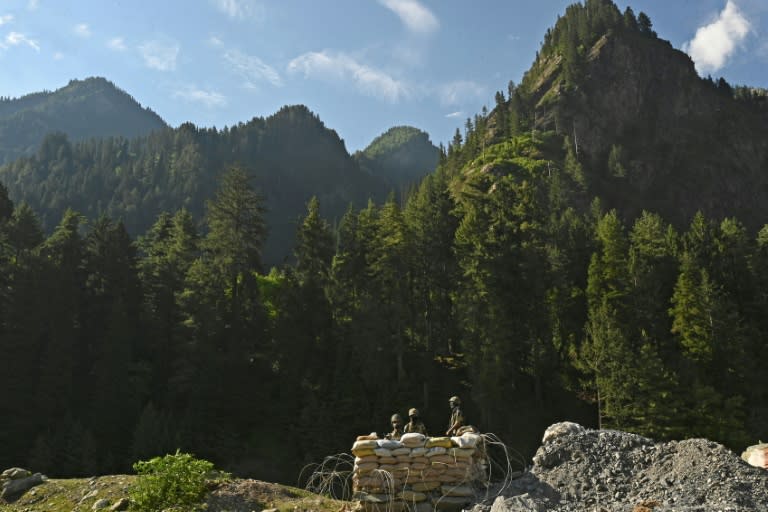
Weather, which can change quickly with little warning, and the hilly terrain can impair radio communication (AFP Photo/Tauseef MUSTAFA)
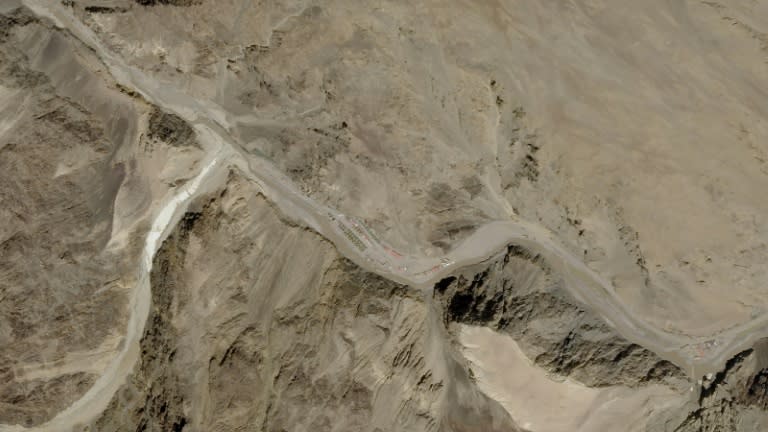
In the 'cold desert' of the Galwan river valley where Indian and Chinese troops fought a brutal hand-to-hand battle, winter temperatures can plunge below minus 30 Celsius (minus 20 Fahrenheit) (AFP Photo/-)
India-China Himalayan standoff deadly for cashmere herds
AIJAZ HUSSAIN Associated PressJune 19, 2020
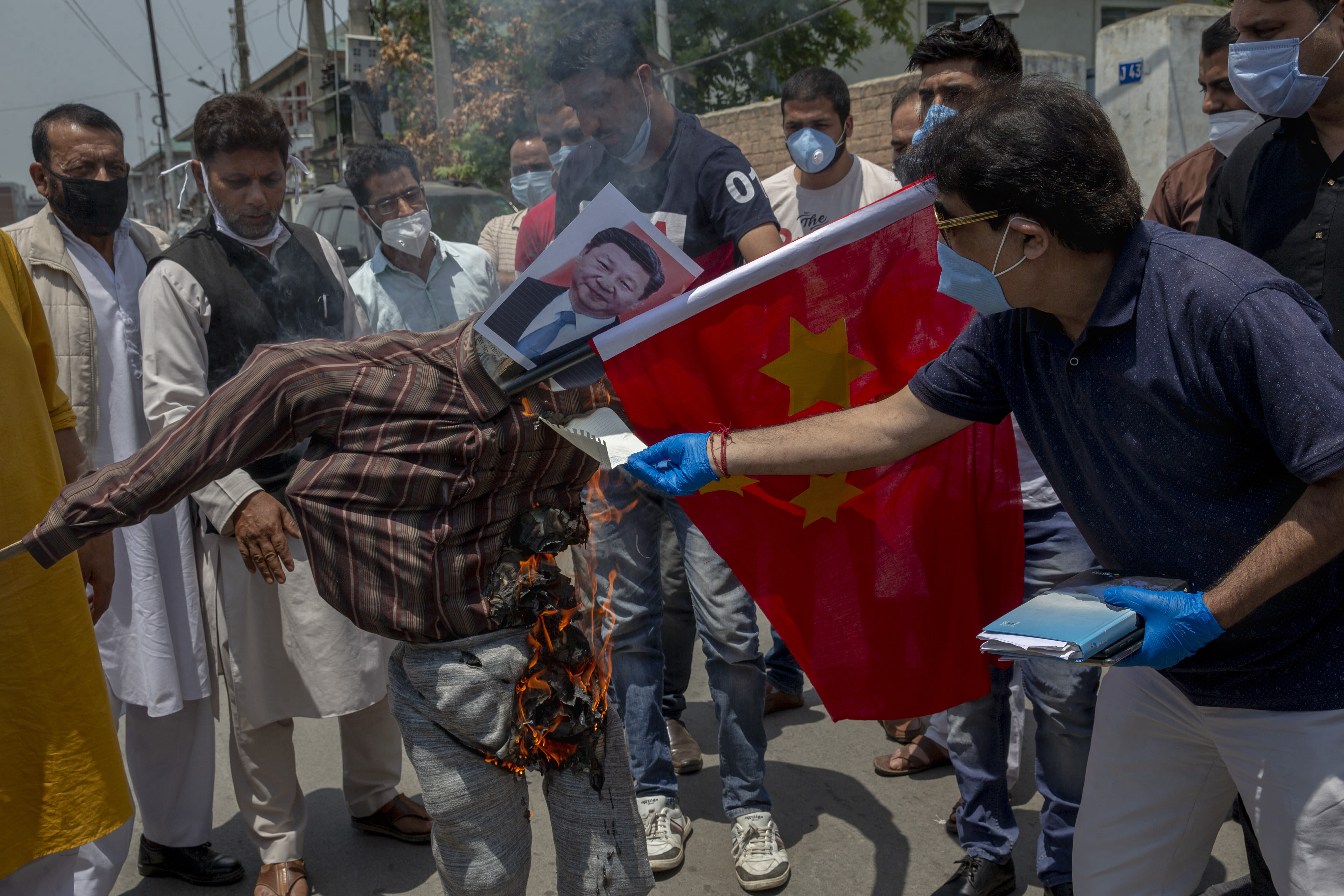
India Kashmir China Himalayan Standoff
Bharatiya Janata Party (BJP) members shout slogans as they burn an effigy of Chinese President Xi Jinping during a protest against China in Srinagar, Indian controlled Kashmir, Friday, June 19, 2020. India's prime minister is meeting top opposition leaders Friday as the government tries to lower tensions with China after 20 Indian soldiers were killed in a clash in a Himalayan border region. India and China accuse each other of instigating the fight in the Galwan Valley, part of the disputed Ladakh region along the Himalayan frontier. It was the deadliest conflict between the sides in 45 years. China has not said whether it suffered any casualties. (AP Photo/ Dar Yasin)

In this July 21, 2007, file photo, an elderly man belonging to the Changpa, the nomadic herders who rear the Pashmina goats, holds his Himalayan goat as his son cuts its horn that was hurting the animal's eye in Kharnak, some 185 kilometers (116 miles) from Leh, India. A months-long military standoff between India and China in 2020 has taken a dire toll on local communities as tens of thousands of Himalayan goat kids die because they couldn't reach traditional winter grazing lands, officials and residents said. (AP Photo/Dar Yasin, File)
SRINAGAR, India (AP) — Antagonisms between Indian and Chinese troops high in the Himalayas are taking a dire toll on traditional goat herds that supply the world’s finest, most expensive cashmere.
This week, a deadly brawl between Indian and Chinese soldiers caused the deaths of at least 20 Indian soldiers in the Galwan Valley, an achingly beautiful landscape that is part of a border region that has been disputed for decades because of its strategic importance as the world's highest landing ground.
The months-long military standoff between the Asian giants is hurting local communities due to the loss of tens of thousands of Himalayan goat kids died because they couldn't reach traditional winter grazing lands, officials and residents said.
Nomads have roamed these lands atop the roof of the world, around the undemarcated borders with China and Tibet, for centuries, herding the famed and hardy goats that produce the ultrasoft wool known as Pashmina, the finest of cashmeres.
ashmere takes its name from the disputed Kashmir valley, where artisans weave the wool into fine yarn and exquisite shawls that cost up to $1,000 apiece in world fashion capitals in a major handicraft export industry that employs thousands.
This latest bout of friction between the rival nuclear powers is adding to pressures from climate change and longer-term losses of grazing land for the Changpa, the nomadic herders who rear the Pashmina goats.
With access to the usual breeding and birthing grounds blocked by militaries on either side, newborn goats are perishing in the extreme cold of higher elevations, herders say.
“Denial of pastureland has led to high mortality of goat babies. It’s so scary, it has never been like this,” said Sonam Tsering, the general secretary of All Changtang Pashmina Growers Cooperative Marketing Society.
He said thousands of newborns died this year because most of the 300,000-strong herd of goats, which yields around 45 tons of fine feather-like wool each year, remained trapped in the extreme cold.
uthorities in Leh, the capital of Indian-controlled Ladakh, would not give any information, saying they were still collecting data.
But two officials with Ladakh’s animal husbandry department said that according to field staff, the deaths were much higher than the usual 5 to 10% mortality rate among some 60,000 to 80,000 kids each year. They spoke on condition of anonymity because they said the Ladakh administration has barred them from speaking to reporters.
Demand for the cashmere, which is painstakingly combed from the goats, sorted, cleaned and hand woven, has always outstripped supply, so shortages are a certainty, said several people working in the trade.
“It’s going to be catastrophic for wool production,” said Namgyal Durbuk, a village official in the region.
India and China fought a border war in 1962 that also spilled into Ladakh. The two countries have been trying to settle their border dispute since the early 1990s without success, as their soldiers face off along a thousands-of-miles-long, undemarcated frontier that stretches from Ladakh in the north to the Indian state of Sikkim in the northeast.
For most of the year the Changpa raise their herds in the vast cold desert of the Changtang plateau of Ladakh, which straddles Tibet at over 5,000 meters (16,404 feet) above sea level.
The harsh, windy climate is what causes the goats to grow their super-soft wool. But the Abecomes inhospitable from December to February, when temperatures can fall to minus 50 Celsius (-58 Fahrenheit).
That's when the Changpas bring their livestock to slightly lower elevations and warmer grazing lands in the Demchok, Hanle, Korzok, Chumar and Chushul areas near the disputed border with China.
This year, Indian authorities barred their passage for months, several people involved with herding said.
The two sides blame each other for Monday night's clash, their deadliest conflict in 45 years.
Tensions have surged since August, when India unilaterally declared the region a federal territory while separating it from disputed Kashmir. China is among a handful of countries that strongly condemned the move, raising it at international forums including the U.N. Security Council.
Indian officials have kept a near-total silence on issues related to the confrontation with China. However, a security official in Ladakh, speaking on condition of anonymity in keeping with government regulations, said the grazing lands are close to the contested frontier and the restrictions in place in the area are to protect herders from Chinese soldiers.
Around 1,200 Changpa families have lost access to grazing lands even in the areas that are controlled by the Indian military due to the confrontation, Tsering said.
But the Chinese side also is interfering, he and other herders said.
Our nomads in recent years have increasingly faced difficulty in accessing pastures in these places. Chinese soldiers have blocked them while bringing herders from Tibet into our lands,” said Tsering.
Phuntsog, a local farmer who uses only one name, said local elders have been complaining to the Indian government about Chinese incursions for years.
“They would ignore every time. Now see where the Chinese are. Worst, these hapless, beautiful creatures which sustain our livelihood are becoming victim of this political and military game,” he said.
China's foreign ministry said Thursday that such allegations are “sheer fiction.” “Chinese border troops have always only patrolled Chinese territories,” the ministry said.
Tsering said herders began losing terrain years ago, when Chinese began “snatching our pasturelands in a concerted way over the years, like inch by inch.” He cited an example of a vast winter pastureland known as Kakjung, close to the Indus river.
“For the past four years it’s a no-go-zone for us. They (Chinese) have taken full control of it,” he said.
___
Associated Press reporters in Beijing contributed to this report.





Galwan Valley: The fake news about India and China's border clash
Reality Check team - BBC News BBC•June 19, 2020

Feelings run high at an anti-China protest in Delhi
Following the deadly clash between Chinese and Indian forces in a disputed Himalayan border area this week, misleading images and videos have been widely shared by social media users.
We've found examples of images and video posted online claiming to be of the latest clash, but which are in fact completely unrelated.
1. A video claiming to show soldiers in combat

Screen grab of video labelled three years old
Our first example is a video on YouTube claiming to show the "real fight" between Indian and Chinese soldiers in the Galwan river valley, where the recent clash took place.
It's had more than 21,000 views, and also been widely viewed on Twitter, where some posts talk of the Indian army "kicking out" Chinese forces.
However, the video is shot in daylight, whereas the latest clash in the Ladakh region took place at night.
We've also found this same video posted both in August 2017 and September 2019, on both occasions claiming to show previous skirmishes between Indian and Chinese troops.
The freezing battlefield where India and China clashed
The soldiers killed in the India-China border clash
2. Indian soldiers mourning casualties is not what it appears
A video depicting an emotional scene with Indian soldiers crying and hugging, as others carry what appears to be a body bag, is doing the rounds on social media.

Screen grab of video labelled wrong location
It's been tagged by some users as related to the Galwan valley clash this week.
However, the video is from an incident more than a year ago in the Kashmir region, when Indian forces sustained a number of casualties in a confrontation with armed militants.
It's not connected at all to the current incident between Indian and Chinese troops in a disputed border area.
3. An old argument between military officers
Twitter post showing a video of soldiers from China and India arguing has had thousands of views.

Screen grab of video labelled old
The Chinese troops are scolding an Indian soldier, and demanding that he leaves.
The video has been posted on TikTok's Chinese-language site, and has got more than 33,000 likes and has also been shared by the spokesperson of India's opposition party, the Indian National Congress.
However, the same video had also appeared on social media platforms in May, so it predates this week's clash. And a search reveals that the video was uploaded to YouTube in January this year.
Apart from that, it's pretty clear from the terrain depicted that the video is not from a mountainside in Ladakh.
Although we can't establish the exact location, a report by one fact-checking site suggests that it was from a border area in Arunachal Pradesh state, at least 1,000 miles away.
4. A funeral for a fallen Indian soldier
Another widely-shared video shows the funeral ceremony for an Indian army man, with his fellow-soldiers shouting out and chanting.

Screen grab of video labelled wrong incident
The video - viewed about 40,000 times - refers to the Galwan valley clash and praises Indian soldiers.
The video, however, has nothing to do with the soldiers who died on 16 June.
A reverse image search shows that a similar video was posted on YouTube in May.
Listening to the video, you can just make out the name of the soldier, and a keyword search on Google shows that the soldier in the video died in an accident in the Leh-Ladakh region in May.
The soldier's funeral took place in his home town in the state of Maharashtra, where he was given full state honours.
5. Images of dead bodies and coffins are the wrong continent
A Chinese-language article on the recent India-China violence contains images purportedly showing the dead bodies of Indian soldiers from the clash.

Screen grab of video labelled wrong country
The article has been read more than 100,000 times, and an image from it has also been used on a Pakistani news website called Baaghitv.
The same image has also cropped up on social media.
A simple reverse image search showed that it's actually from Nigeria. It depicts the aftermath of an incident in 2015, when Nigerian soldiers were killed by Boko Haram militants.
And another image in the same article showing several army coffins with wreaths is the same as an image posted on social media in February 2019 after a major attack on Indian forces in the Pulwama district of Indian-administered Kashmir.
So again, this is completely unrelated to the current clash.
 Banner
Banner Reality Check branding
Reality Check brandingIndia-China clash: An extraordinary escalation 'with rocks and clubs'

Soutik Biswas India correspondent
16 June 2020
Related Topics
China-India border dispute

REUTERS
The two nuclear armed neighbours have a chequered history of face-offs
"It is looking bad, very bad," says security analyst Vipin Narang, of the deadly clash between Indian and Chinese soldiers in Ladakh on Monday night.
The most serious face-off on the world's longest unsettled land border in nearly half a century left 20 Indian soldiers dead. India says both sides suffered casualties.
"Once fatalities are sustained, keeping everything quiet becomes hard on both sides. Now public pressure becomes a variable," Dr Narang, a security studies professor at Massachusetts Institute of Technology, told me.
"The scale, scope and swathe of the pressure across the border is seemingly unprecedented."
The two nuclear armed neighbours have a chequered history of face-offs and overlapping territorial claims along the more than 3,440km (2,100 mile), poorly drawn Line of Actual Control (LAC) separating the two sides. Border patrols have often bumped into each other, resulting in occasional scuffles. But no bullets have been fired in four decades.
That is why the latest clash, following months of roiling tension, has taken many by surprise.
"It is an extraordinary escalation," Shashank Joshi, Defence Editor at The Economist magazine, told me. "No shots fired for 45 years, and then at least 20 soldiers dead in one evening in rock-throwing and bludgeoning." The clash comes amid fresh tensions between the two powers, which have brawled along the border in recent weeks but not exchanged any gunfire.
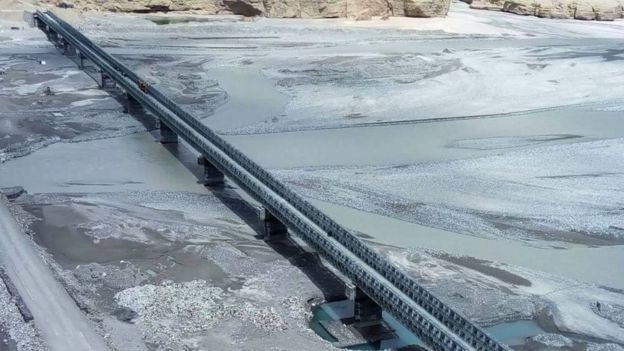
PRESS INFORMATION BUREAU
The area has become a hotspot in part because of a road India has built
Reports say in early May, Chinese forces put up tents, dug trenches and moved heavy equipment several kilometres inside what had been regarded by India as its territory in Galwan valley in Ladakh. Ajai Shukla, a leading Indian defence analyst, has claimed that China had captured 60 sq km of Indian-patrolled territory in the area in the past one month. India claims China already occupies 38,000sq km (about 14,700sq miles) of its territory.
The move came after India built a road several hundred kilometres long connecting to a high-altitude forward air base which it reactivated in 2008.
'One of the most serious crises in years'
The details of how Monday's skirmish unfolded remain fuzzy.
India and China are accusing each other of violating the consensus to respect the Line of Actual Control that separates the both sides in the Galwan Valley.
India says the two sides have been exploring military and diplomatic channels to de-escalate the situation and that senior commanders had a "productive meeting" on 6 June. They agreed "on a process of de-escalation" and subsequently, the ground commanders had a series of meetings to implement the consensus, India's foreign ministry said.
India said both sides suffered casualties after the Chinese "unilaterally tried to change the status quo." And China accuses India troops of "violating" the consensus, crossing the border twice and carrying out provocative attacks on Chinese personnel".
Ankit Panda, a senior editor at The Diplomat magazine, says the ongoing crisis was "already among the most serious between the two countries - certainly since the 2017 Doklam standoff and possibly much longer". Road construction by the Chinese triggered a 73-day standoff in 2017 at a junction of India, China and Bhutan.
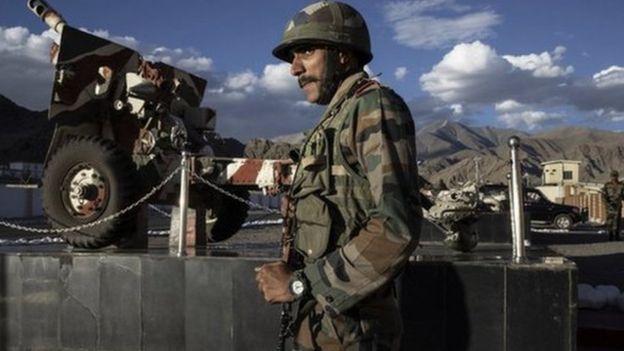
GETTY IMAGES An Indian soldier at the border in Ladakh
But Chinese behaviour this time has "been very different from what we have seen in the past," Shivshankar Menon, a China expert and a former national security advisor, says.
"What we have seen is multiple incidents, multiple moves forward and China occupying spaces which it never occupied before along the LAC. This is a worrying sign because it's different from Chinese behaviour in the past," Mr Menon told interviewer Karan Thapar in The Wire, an independent online news portal.
Theories abound on the reasons behind China's actions in the area.
In a tactical sense, Delhi's beefing up of the border infrastructure may have triggered the Chinese army into action in Ladakh. The pandemic may have provided the cover for China to act, particularly as the Indian army had delayed exercises in Ladakh in March. "But I doubt it was the only cause," says Mr Joshi.
"Is it about the road? Is it about Article 370 [India's action of unilaterally changing the status quo of Kashmir in August last year] Is it broader aggressiveness? We don't know," says Dr Narang. "But it is tense and it is not over."
Mr Menon, who served as India's ambassador to China, believes that China is resorting to strident nationalism, due to "domestic and economic stresses" at home. "You can see it in their behaviour in Yellow Sea, towards Taiwan, passing laws without consulting Hong Kong, more assertive on India's border, a tariff war with Australia."
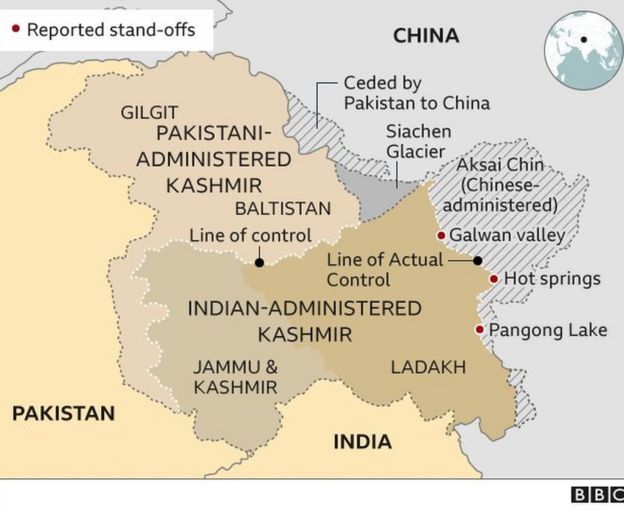
On Tuesday evening, India said the troops had disengaged from the clash site. Early reports suggest that established military channels were being used and both sides were not escalating. "That's good news for India, which has few credible retaliatory options in the current environment," says Mr Panda.
Mr Joshi believes the most important consequences of Monday's clashes will be the "wider and long-term diplomatic one".
"For 10 years, Sino-Indian rivalry has steadily intensified, but remained largely stable," he said. India and China have also been more engaged. Bilateral trade increased 67 times between 1998 and 2012, and China is India's largest trading partner in goods. Indian students have flocked to Chinese universities. Both sides have held joint military exercises.
"Now we may be entering a new period of heightened mistrust and antagonism washing away much of the bonhomie on display at the Wuhan summit in 2018," says Mr Joshi.
India-China clash: 20 Indian troops killed in Ladakh fighting
16 June 2020
Related Topics
China-India border dispute

GETTY IMAGES
India and China have been locked in a border dispute for decades
At least 20 Indian soldiers were killed in a clash with Chinese forces in a disputed Himalayan border area, Indian officials say.
The incident follows rising tensions, and is the first deadly clash in the border area in at least 45 years.
The Indian army initially said three of its soldiers had been killed, adding that both sides suffered casualties.
But later on Tuesday, officials said a number of critically injured soldiers had died of their wounds.
India's external affairs ministry accused China of breaking an agreement struck the previous week to respect the Line of Actual Control (LAC) in the Galwan Valley.
BBC diplomatic correspondent James Robbins says violence between two armies high up in the Himalayas is very serious, and pressure will grow on the two nuclear powers not to allow a slide into full-scale conflict.
What have both sides said about the incident?
Early on Tuesday the Indian army said three of its soldiers, including an officer, had died in a clash in Ladakh, in the disputed Kashmir region.
Later in the day, it released a statement saying the two sides had disengaged.
It added that "17 Indian troops who were critically injured in the line of duty" and died from their injuries, taking the "total that were killed in action to 20".
China did not confirm any casualties, but accused India in turn of crossing the border onto the Chinese side.
Chinese foreign ministry spokesman Zhao Lijian said India had crossed the border twice on Monday, "provoking and attacking Chinese personnel, resulting in serious physical confrontation between border forces on the two sides", AFP news agency reported.
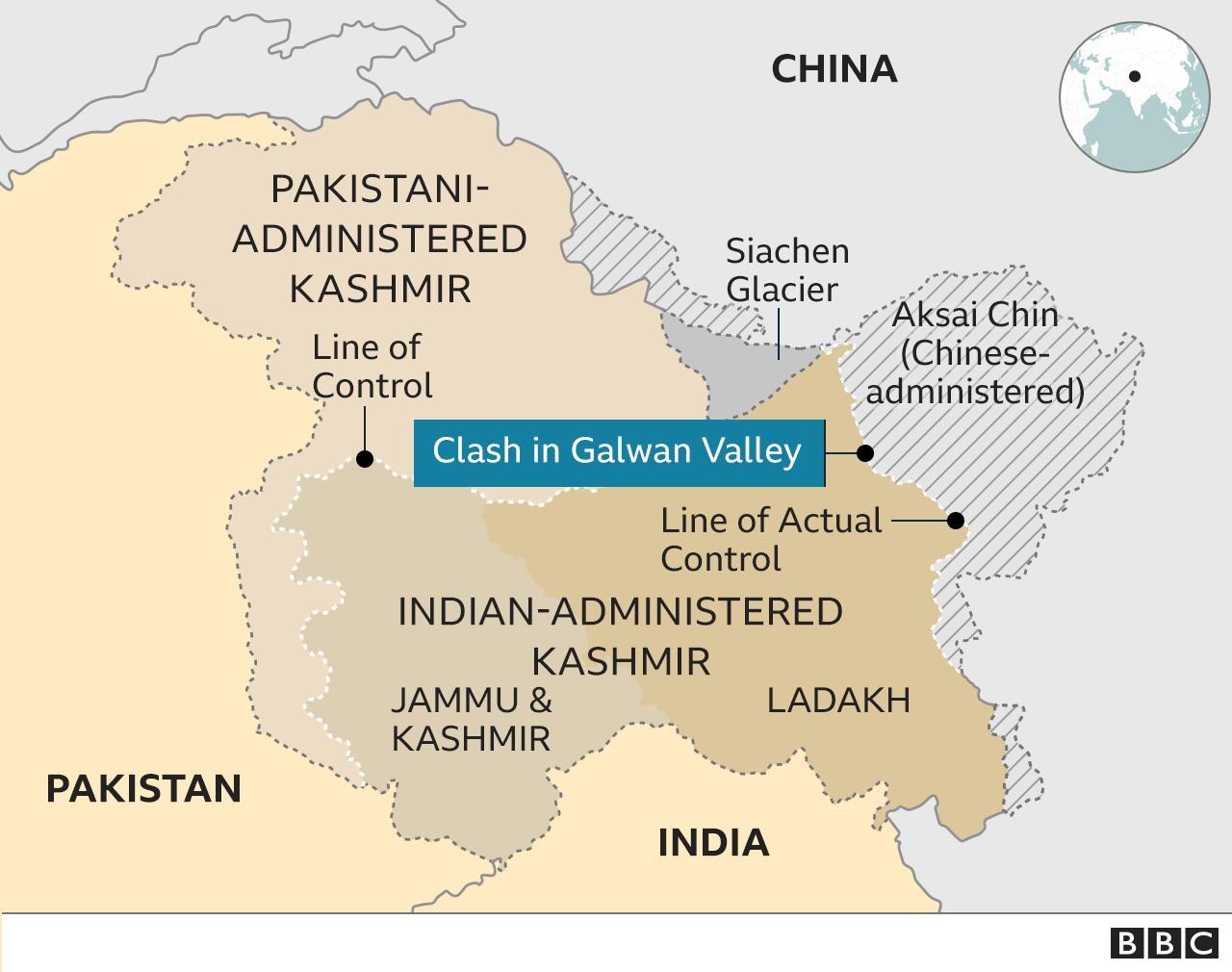
Both sides insist no bullet has been fired in four decades, and the Indian army said on Tuesday that "no shots were fired" in this latest skirmish.
How a clash that did not involve an exchange of fire could prove so lethal is unclear. There are reports that it was fought with rocks and clubs
Local media outlets reported that the Indian soldiers had been "beaten to death".
How tense is the area?
The LAC is poorly demarcated. The presence of rivers, lakes and snowcaps means the line can shift. The soldiers either side - representing two of the world's largest armies - come face to face at many points.
But there have been tense confrontations along the border in recent weeks
India has accused China of sending thousands of troops into Ladakh's Galwan valley and says China occupies 38,000sq km (14,700sq miles) of its territory. Several rounds of talks in the last three decades have failed to resolve the boundary disputes.
The two countries have fought only one war so far, in 1962, when India suffered a humiliating defeat.
In May, dozens of Indian and Chinese soldiers exchanged physical blows on the border in the north-eastern state of Sikkim. And in 2017, the two countries clashed in the region after China tried to extend a border road through a disputed plateau.
There are several reasons why tensions are rising now - but competing strategic goals lie at the root, and both sides blame each other.
India has built a new road in what experts say is the most remote and vulnerable area along the LAC in Ladakh. And India's decision to ramp up infrastructure seems to have infuriated Beijing.
The road could boost Delhi's capability to move men and materiel rapidly in case of a conflict.
India also disputes part of Kashmir - an ethnically diverse Himalayan region covering about 140,000sq km - with Pakistan.
Kashmir: Why India and Pakistan fight over it


The two nuclear armed neighbours have a chequered history of face-offs and overlapping territorial claims along the more than 3,440km (2,100 mile), poorly drawn Line of Actual Control separating the two sides.
Border patrols have often bumped into each other, resulting in occasional scuffles. But no bullets have been fired in four decades.
That is why Sunday's night's clash following months of roiling tension has taken many by surprise.
Whatever the result, the latest incident is likely to trigger a fresh wave of anti-China sentiments in India.
It will also present daunting foreign policy and security challenges to Indian Prime Minister Narendra Modi and his government, which is struggling to contain a surge of Covid-19 infections and revive an economy which looks headed for recession.
Ten captured Indian soldiers released by China as evidence grows Beijing planned Ladakh ambush

Joe Wallen The Telegraph•June 19, 2020

At least 76 Indian soldiers remain injured after the clash between the two superpowers in Galwan Valley - Tauseef Mustafa/AFP
Ten Indian soldiers captured by China in Ladakh on Monday evening have been released, as evidence grows Beijing “meticulously planned” the ambush.
The Indian Army has said no further troops are being held prisoner but 76 Indian soldiers remain injured, after Chinese troops attacked Indian forces with brutal weapons including nail-embedded rods.
Indian intelligence agencies flagged the unusual movement of Chinese soldiers to bases on the Tibetan side of the Line of Actual Control, which separates the two superpowers, as early as February.
Yet, Indian troops were slow to reinforce after the Himalayan spring snow due to the coronavirus and members of the People’s Liberation Army (PLA) crossed the LAC and annexed 60 square kilometres of Indian territory at four locations - Pangong Tso Lake, Galwan River and Valley, Hot Springs and Demchok.
Former leader of the opposition, Rahul Gandhi, tweeted today that it was “crystal clear” that the government was “fast asleep”.
The Indian Army has officially declared that 20 Indian soldiers were killed in clashes but on condition of anonymity, sources told the Telegraph this figure was 23, as three bodies were unidentifiable due to the injuries inflicted by the Chinese weapons.
The Deccan Chronicle quoted intelligence sources today, saying the actual number of fatalities on the Indian side is as high as 40, as bodies fell in the Galwan River or are buried in deep snow on the mountainside.

Indian Army sources shared a photo of a nail-studded rod used by Chinese troops
A Chinese foreign ministry spokesperson said Beijing was not privy to any Indian prisoners: "As far as I know China has not detained any Indian personnel," said Zhao Lijian.
Official Indian sources say China suffered 35 casualties during the clash, quoting U.S intelligence material, a development Beijing said it also wasn’t aware of.
In the days leading up to Monday’s clash, satellite footage obtained by Earth-imaging company Planet Labs shows China brought in machinery, cut grooves into the mountainside and may have damned the Galwan River to change its flow.
A senior Indian government official told the Hindu newspaper that the PLA “meticulously planned” the ambush on an Indian patrol, which had set off to ascertain whether Chinese troops had withdrawn from the Galwan Valley, as per an agreement between senior army officers from the two nations.
The source said China was able to release freezing water at a high speed having blocked small rivulets, which made the Indian soldiers lose their balance.
The armed Chinese troops then charged and many Indian soldiers were either beaten to death or fell into the Galwan River below.
“It was pre-planned by China and Indian forces will give a befitting reply,” cautioned Indian Union Minister, Shripad Naik.
Bilateral talks are continuing today and both sides have expressed a desire to reach a peaceful resolution but Indian Prime Minister Narendra Modi is under increasing pressure from some MPs to respond with force.
Galwan Valley: India and China downplay reports of soldier release
BBC•June 19, 2020
 A cremation ceremony for one of the Indian soldiers killed took place on Thursday
A cremation ceremony for one of the Indian soldiers killed took place on ThursdayChina has denied having any Indian soldiers currently in custody, as both sides try to lower the temperature following a fatal clash along their disputed border in the Galwan Valley.
Indian media had reported that China detained 10 Indian soldiers in the fight, releasing them on Thursday.
Chinese government spokesman Zhao Lijian said on Friday that no Indian soldiers were "currently" being held.
The Indian government said only that none of its soldiers were missing.
The careful wording of the statements did little to clarify whether Chinese forces in the contested area had taken Indian soldiers into custody and subsequently released them.
Indian media reports suggested that a lieutenant-colonel and three majors were among 10 held by the Chinese, and that their release was the top priority in military and diplomatic talks between the nuclear powers on Wednesday.
Asked at a press conference about the reports, Mr Zhao said: "As far as I know, currently, China has not detained any Indian personnel".
The conflicting reports were the latest round of confusion over what exactly happened in the Galwan Valley on Monday.
At least 20 Indian soldiers died in the clash, which was fought without any firearms because of a 1996 agreement barring guns and explosives from the area, and at least 76 Indian soldiers were injured.
China has not released any information about casualties, though India said both sides suffered losses.
The two nations have accused the other of crossing the poorly demarcated border and provoking the fight.
Shiv Aroor, a senior editor at India Today, tweeted on Thursday with what he said were details of the release of the Indian troops.
To those asking, (and since it’s been reported now) — that’s what my tweet below 6 hours ago was meant to convey. And since the story will be in tomorrow’s papers, if you’re interested in hearing about it from me, here you go: https://t.co/xsMJtUWdaW pic.twitter.com/lxfQKb608N
Shiv Aroor (@ShivAroor) June 18, 2020
In his press conference Mr Zhao, acknowldged that the two nations were in communication over diplomatic and military channels. "We hope India can work with China to maintain the long-term development of bilateral relations," he said.
No comments:
Post a Comment